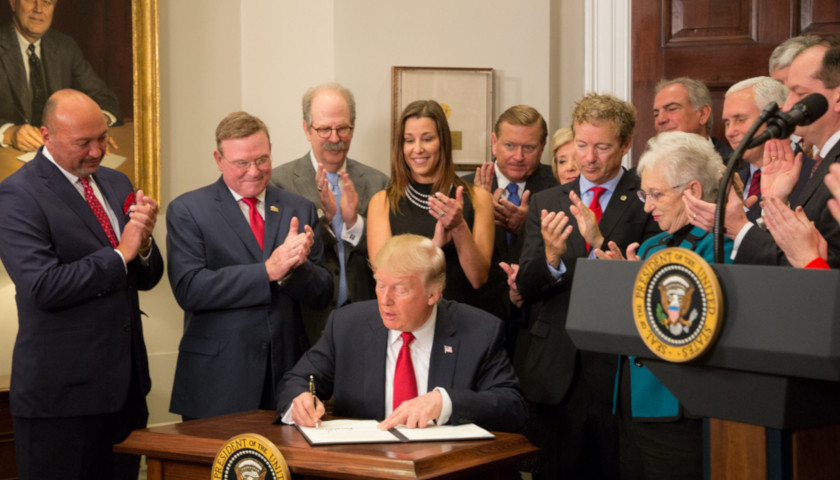by Mary Fishpaw
The Trump administration is offering welcome relief to Americans struggling with high premiums under Obamacare premiums and a lack of insurance choices.
The administration has taken a series of regulatory actions to do the following:
- Make short-term, limited duration policies widely available and give consumers the right to renew those policies.
- Make it easier for small businesses and independent contractors to band together for greater insurance purchasing power.
- Propose to allow employers to contribute to tax-advantaged accounts, which their workers could then use to purchase portable insurance coverage.
The Department of Health and Human Services also has made it easier for states to promote more affordable, flexible insurance coverage options by obtaining waivers from restrictive Obamacare regulations.
These “State Empowerment and Relief Waivers” enable states to tap money that the federal government would have paid directly to insurance companies in the form of premium subsidies. States could repurpose this money to design and implement their own premium assistance programs. Such programs could distribute subsidies through defined contributions to consumer-directed accounts established for low-income individuals.
States also could provide premium subsidies for insurance policies that don’t conform to Obamacare’s rigid requirements.
States that obtain these waivers would be able to reduce premiums and increase health insurance choices for their residents, while still protecting vulnerable people such as those with pre-existing conditions.
The Department of Health and Human Services is establishing this waiver program under Section 1332 of the Obamacare statute, which permits states to deviate from the Obamacare framework so long as their plan maintains coverage rates, assures the availability of policies offering coverage that meet Obamacare requirements, and makes insurance more affordable, all without increasing the federal deficit.
The Obama administration had placed excessively restrictive conditions on these waivers, inhibiting state innovation. Health and Human Services earlier this fall relaxed those requirements, and last month issued what it called “waiver concepts,” which describe categories of waivers the administration would be inclined to approve.
These include:
- Account-based subsidies. Under this concept, states would repackage Obamacare subsidies to go directly to individuals. This would be a change from today’s approach, which sends money directly to insurance companies. Subsidized individuals would get their money in accounts they own and control, and could use these accounts to pay premiums as well as cover medical expenses. The account also would allow recipients to aggregate funding from nongovernment sources, including individual and employer contributions.
- State-specific premium assistance. Obamacare subsidies are income-related and offer little relief for those with incomes above 200 percent of the federal poverty level (roughly $24,000 in annual income). A state could restructure the subsidies in ways that work better for the unique needs of its population. It could offer assistance to a broader swath of its population and use them to make policies more attractive to young adults.
- New plan options. Obamacare limits the choices available to premium recipients, only allowing them to use their subsidies to buy policies that meet all of the law’s requirements. Under this waiver option, a state could give subsidy-eligible individuals the right to use their subsidies to buy the coverage of their choice.
- Protecting people with high medical costs through risk stabilization strategies. States could also obtain waivers to establish programs that direct public resources to those in greatest medical need. A state could, for example, establish a separate pool for consumers with specified medical conditions that make them more likely to incur large medical bills. Public resources would be directed to that pool to better serve those with the greatest health care costs, while providing premium relief to those in better health. Seven states already have obtained waivers to operate programs of this sort. Premiums have come down in all of those states.
States can advance proposals that combine these ideas. They could, for example, fund a high-risk pool and provide premium subsidies in the form of contributions to consumer-directed, individual accounts.
These waiver concepts could spur a wave of patient-centered innovation. One of Obamacare’s core conceits was that what (allegedly) worked in Massachusetts would also work in Mississippi, Missouri, and Montana. That hasn’t borne out.
Under Obamacare, premiums have skyrocketed, networks have narrowed, insurance choices have contracted, and people have fled the individual market by the millions. As of December 2017, there were 2.3 million fewer unsubsidized people with individual policies than in December 2013, the month before Obamacare took full effect. An estimated 2.3 million unsubsidized people left the market between March 2017 and March 2018.
Individuals and states have been bystanders as a Washington-imposed regime wreaked havoc on their insurance markets. State Empowerment and Relief Waivers offer states the opportunity to implement innovative ideas that bring at least a measure of relief to beleaguered residents.
Congress should go further and enact the Health Care Choices Proposal, which would provide states with resources and more flexibility to breathe life into their ailing insurance markets. The proposal would replace Obamacare entitlements with grants to states, which would design consumer-centered programs to make insurance affordable, regardless of income or health status.
The new waivers, while a helpful first step toward these goals, still force states to obtain Washington’s permission to deviate a bit from federal guidelines. Under the Health Care Choices Proposal, each state would take the lead in assuring that its residents—including those who need assistance to afford coverage—would be free to choose among a range of affordable insurance products.
The Health Care Choices Proposal would reverse Obamacare’s polarity, empowering state governments, rather than Washington bureaucrats, to set insurance policy.
Because State Empowerment and Relief Waivers must function within Obamacare’s architecture, they offer states only a small measure of flexibility. They are nevertheless a step in the right direction.
States should seize the opportunity to provide their consumers lower costs and more health care choices.
– – –
Marie Fishpaw is director of domestic policy studies at The Heritage Foundation’s Institute for Family, Community, and Opportunity.






[…] Source […]